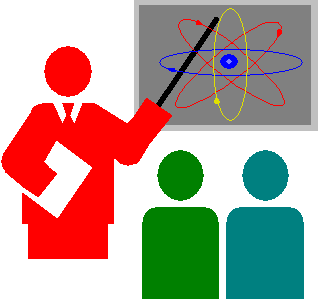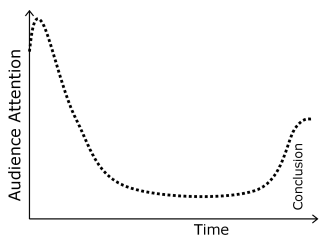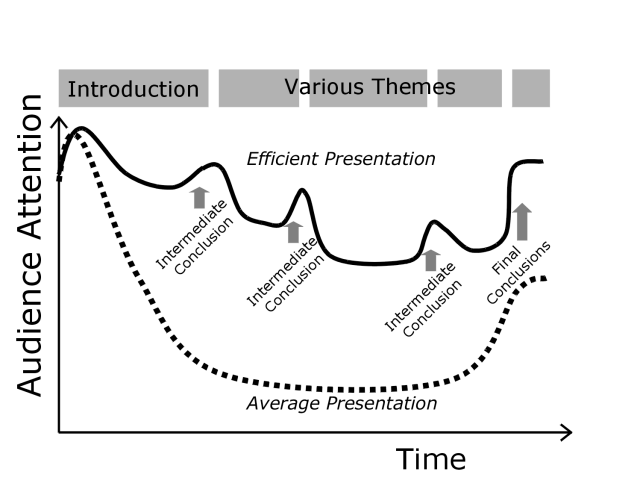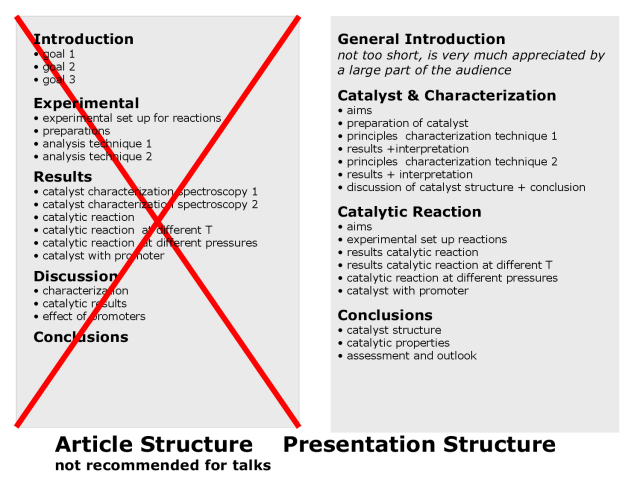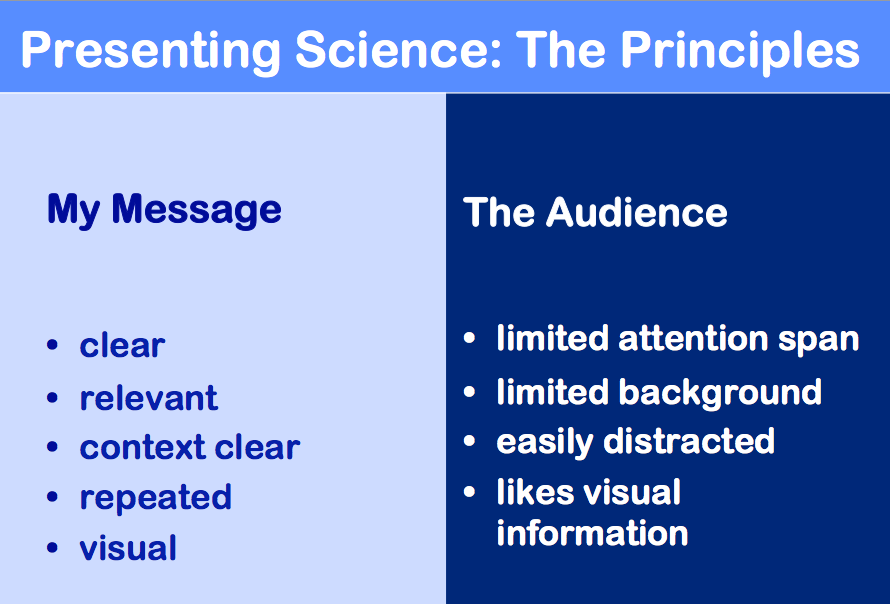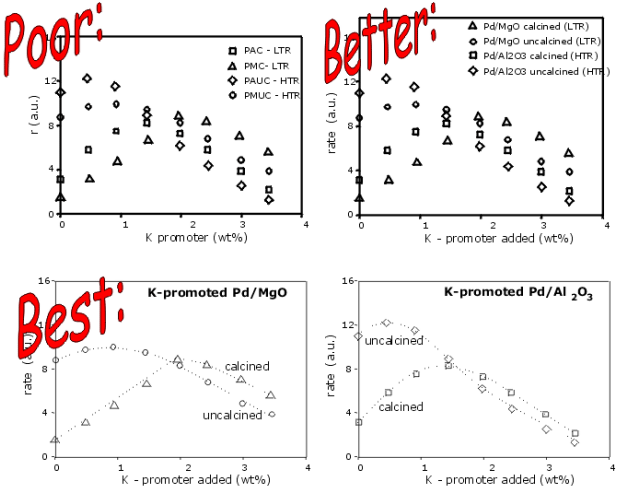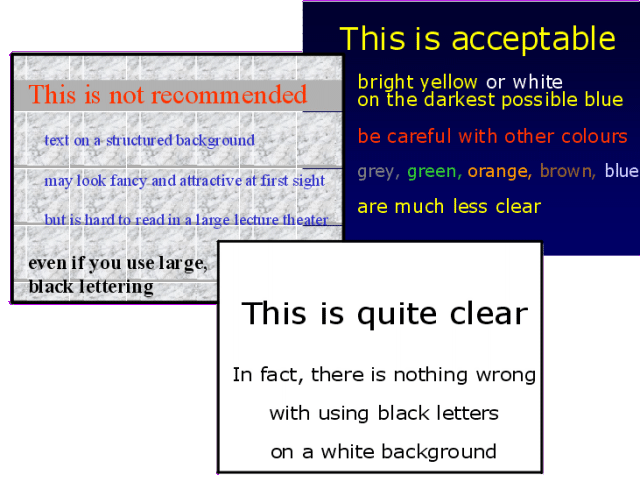How to Give Successful Oral Presentations
Develop your own style, but try to avoid the obvious mistakes.
see also “Presenting Science” on www.catalysiscourse.com
1. Introduction – how many presentations are really useful?
2. The attention curve – help the audience to focus on the message.
3. Why are audiences distracted?
4. How to organize your presentation (and how not).
5. In ten steps to a successful presentation.
6. Conclusion – develop your own style but avoid the common mistakes!
How often have you been listening to oral presentations that dealt with interesting science while you nevertheless had difficulty to pay attention till the end? How often did you lose your interest before the speaker had even come halfway? Was it because of the subject of the talk or was it the way the speaker presented it?
Many presentations concern interesting work, but are nevertheless difficult to follow because the speaker unknowingly makes a number of presentation errors. By far the largest mistake is that a speaker does not realize how an audience listens. If you are well aware of what errors you should avoid, the chances are high that you will be able to greatly improve the effectiveness of your presentations.
Figure 2. Ideal attention curve of an audience when the speaker divides his talk in recognizable parts, each summarized by intermediate conclusions. If people loose their attention for some reason, they can easily catch up with the speaker in one of his intermediate summaries. The big advantage of this approach is that every important item is said several times. Repeating the essentials is the key to getting your message across.
2. The Attention Curve – help the audience to focus on your message.
The average attendee of a conference is by all means willing to listen to you, but he is also easily distracted. You should realize that only a minor part of the people have come specifically to listen to your talk. The rest is there for a variety of reasons, to wait for the next speaker, or to get a general impression of the field, or whatever.
Figure 1 illustrates how the average audience pays attention during a typical presentation of, let’s say, 30 minutes. Almost everyone listens in the beginning, but halfway the attention may well have dropped to around 10-20% of what it was at the start. At the end, many people start to listen again, particularly if you announce your conclusions, because they hope to take something away from the presentation.
What can you do to catch the audience’s attention for the whole duration of your talk? The attention curve immediately gives a few recipes:
- Almost everyone listens in the beginning. This is THE moment to make clear that you will present work that the audience cannot afford to miss.
- If you want to get your message through, you should state it loud and clear in the beginning, and repeat it at the end.
- The best approach, however, is to divide your presentation in several parts, each ended by an intermediate conclusion, see Figure 2. People in the audience who got distracted can always easily catch up with you, particularly if you outline the structure of your talk in the beginning.
3. Why are audiences distracted?
There are many reasons why this may happen, some may be outside your control, such as inadequate sound systems, poor beamers, or noisy conference centers with cardboard walls between two sessions running in parallel. Bad luck if it concerns your talk.
What you can do yourself, however, is avoid anything that may encourage the audience to stop listening. Such mistakes fall in two classes: speaker’s errors and presentation errors.
We list a couple of the most common ones, most are self explanatory.
1. The speaker lives in his own little world of research, he believes that all the background information needed to appreciate the meaning of his work is common knowledge. This is seldom the case! Students often assume that the audience knows as much as their supervisor does, which is definitely not the case! Hence, a subject needs to be properly introduced, depending on the specific audience it is presented for.
THE AUDIENCE LOVES BACKGROUND INFO!
You can raise the interest of attendees who are not per definition interested in your subject, by giving them the impression that they will learn something from your talk. Note that this part of the audience is more interested in general aspects than in the details.
You certainly need to give them a good introduction into the background of your subject, before they can fully appreciate the subtleties of your work.
Hence, you should spend at least some 30% of your time on general themes, e.g. what is known about the catalytic reaction and the catalysts and how it is applied in industry, or perhaps a less known method of research that is more generally applicable, etc.
A large part of the audience may find this very useful to know. But what is even more important, with sufficient background information they will understand a lot more about your specific results, i.e. that part of the talk you are most proud of.
Be careful, however, not to include knowledge that is real common knowledge.
You don’t have to explain extensively that fossil fuels will run out at some time, or that CO2 is a problem.
You don’t want to annoy your audience by stating the obvious.
2. The structure of the presentation is unclear, and consequently the line of reasoning is hard to follow. Important matters as problem identification, aims, or motivation are insufficiently clear.
3. Visual aids (PowerPoint slides) are inadequate, confusing, unreadable, too small, too crowded, etc. Some speakers show too many in a too short time (one per minute is not bad as a rule of thumb).
4. The speaker uses long, complicated sentences, or unnecessary jargon, abbreviations or difficult words. Passive sentences (” From this figure it was deduced that …” or “It was therefore concluded that …… ) are more difficult to follow than active ones ( “This figure implies that …” or “Therefore, we conclude that …” ).
5. Even worse is when the speaker reads his speech from paper and forgets that -written language is usually more formal and complicated than language used in everyday conversations. Also, reading out written text goes a lot faster than impromptu speaking. Sometimes politicians suffer from this problem, especially when others write their speeches.
In such cases the audience will definitely experience information overload. Of course we sympathize with the speaker who feels insufficiently confident in English. However, reading a text is almost always an unsatisfactory solution. And after all, nobody in the audience will blame you for a couple of mistakes in the language, English will be a foreign language for the majority of the participants.
6. Monotonous sentences, spoken either too fast or too slow, lack of emphasis, unclear pronunciation, slang, colloquial and fashionable expressions, all make it difficult for the listeners to stay attentive.
Not too fast, please….!
Many speakers have rehearsed their talk so often that in the presentation they speak too fast. Others simply have so much to cover, that the only way to stay within the allotted time is to speed up. Of course, this is not in the interest of the audience, particularly not at an international meeting.
… and try to vary your pace
As a rule of thumb, speaking at 150 words per minute is all right. However, try to vary your rate. Key ideas, complicated points, or concluding remarks (you may want to use one at the end of every slide you show) are best presented at a slower pace.
7. Some speakers turn their back to the audience and watch the projection screen while they are talking, in stead of trying to make visual contact with the audience. Sometimes the reason is that they use the slides to guide themselves through the talk, or they read literally what is written on them. PowerPoint actually has a presentation mode where one can see the current slide plus some speaker’s notes on the computer screen while presenting, which is a better solution than looking at the screen all the time. However, never forget to regularly look to the audience and establish contact.
4. How to organize your presentation (and how not)
You should be aware of the fundamental differences between an oral presentation and a written report. In the presentation the listener by necessity has to follow the order in which the speaker presents his material. The reader of an article or report can skip parts, go back to the materials section, take a preview at the conclusions when he reads the results, etc. Exactly because of this reason, all scientific reports follow the generally adopted structure of Abstract – Introduction – Experimental Methods – Results – Discussion – Conclusions – References . However, this structure is totally UNSUITABLE for an oral presentation. Nevertheless, the majority of contributed talks at a conference adheres to it.
Why is this generally accepted report structure unsuitable for oral presentations? Because the listener will have to remember details about e.g. the experimental methods until the results are presented, and he must recall the various results when the speaker deals with the discussion, etc.. In other words, details that should be combined (the why, how, what and what does it mean of a particular experiment) are treated separately. You ask a lot from the audience if they need to remember all these facts and figures until at the end you explain how these bits and pieces fit in a larger picture!
Figure 3. In an oral presentation you should group together what belongs together.
Grouping together what belongs together is a much better way to organize your talk. Hence, if you discuss characterization by e.g. XPS, you start this part of the presentation with a few introductory remarks of what you want to learn about your catalyst, how XPS may help you to provide this information, then you show a few results and you discuss what they mean. End with a conclusion.
Then you go to the next item in your presentation, which may be determination of particle size by TEM. When finished with this, you may give an overall conclusion on the state of your catalyst before you go on to speak about catalytic behavior.
5. In ten steps to a successful presentation
You should realize that the two key issues in the preparation of a talk are:
- The message
What do I want the audience to know when I am finished?
- The audience
How do I present my talk such that the audience will understand and remember what I have to say?
Step 1: Start in time.
Once you submitted the abstract to the conference organizers, it is time to start thinking about how you organize the material in a talk if your abstract will have been accepted. Read about the background of your work, read related work, look at your own results regularly and think about the most relevant conclusions. Try to imagine what type of audience you would have and consider what you would have to include as background information.
Step 2: The message
Try to capture the message of your presentation in a single sentence. This is difficult. You will only be able to do this if you really master your subject (which is actually the main requirement for being able to clearly present your work to others).
Step 3: Select your material and order it.
Use the ‘message in a sentence” under 2) as the criterion to select which results to include, in what order, what basic information is needed to appreciate these results, and which experimental details are necessary and which not. Be very critical, any experiment or result that does not contribute to your main message should be left out.
Although it may at first sight seem natural to present your results in the chronological order in which you obtained them, this does not have to be the most ideal order for the audience to understand what you have done. Think about where to discuss highlights, at the beginning? Near the end? Maybe dispersing the remarkable features through the entire talk? It is up to you, but take the order which you feel appeals most to the audience.
The scientific background of your audience determines how much you should explain about experimental approaches, characterization techniques. Be careful NOT to identify your audience with your supervisor, the majority of listeners is unlikely to possess much specific knowledge about your subject. By the way, hardly anyone minds to hear something he already knows, as long as you explain it well, and possibly in an entertaining way.
Step 4: Opening and Introduction
In the opening, i.e. the first few sentences, you catch the attention, for example by a scientific question, or a catchy or maybe even provocative statement. Perhaps you could already give the conclusion of your work too. Try to speak slowly, with emphasis, and look at the audience. Of course, you must have prepared and rehearsed the opening carefully.
However, before you give your opening sentence, it is good to start with “Mister Chairman, Ladies and Gentlemen…” followed by a few seconds of silence, in which you look around to see if people are paying attention. By doing so, you actually force the audience to listen. With these words you also test the sound system, and you ascertain that your important opening lines are going to be heard. In the rest of the Introduction, you sketch the background of your research. Remember that many people will be very interested in a concise summary of the status in your area. Hence, reserve sufficient time (i.e. at least 30% of the total time) for the general aspects of your work. It is good practice to not only clearly identify the scientific question you address, but also give the conclusion of your work, if you wish so. In this way you enable the audience to better follow your reasoning and to anticipate on the outcome of the experiments. In other words, you give them a chance to listen actively. Remember that a scientific presentation is not a detective story which is solved at the conclusion.
DON’T DO THIS
An often heard, but poor start is: “Good morning, ladies and gentlemen. I am … … and today* I’d like to tell you something about my Ph.D. project at the Group of Archaic Chemistry at the University of Science City. The title of my talk is … … . I will start with an Introduction, then explain the experimental techniques, next present the most important results, and finally I hope to draw a few conclusions and I want to acknowledge a few people. So let us start with the Introduction …”
If you open this way you will find yourself in the company of many others. Nevertheless, this is a totally inefficient way to start a presentation. You are simply telling what everybody has read in the program, and was already stated by the chairman. How would you respond if you were in the audience?
*Why do so many people say “today” in their opening sentence? Do they give talks everyday? Try to avoid it! it sounds silly, at least to to the author of this course.
Step 5: Conclusions and Ending
Conclusions should be properly announced to regain full attention. Present your conclusions in relation to the questions you raised in the Introduction. Avoid all irrelevant details. Once you finished the conclusions, you may acknowledge people who helped you (not the coauthors listed in the program) and the Funding Agencies. Then you may end with a final sentence that repeats the message of your talk, for instance: “Ladies and Gentlemen, I hope I have convinced you that XY/Support is a very promising catalyst for converting methane into synthetic gasoline at room temperature.” This is the take-home message that the audience should remember, hopefully in combination with your name and affiliation.
Step 6: Crystal clear figures and schemes have the highest impact
A picture is worth a thousand words. Well, not necessarily. Figures, especially those generated by spreadsheets, may look neat and tidy but at the same time they may be real puzzles (see Figure 4). A good picture to be used in an oral presentation is easy to read (large lettering, good contrast), explains itself (clear title, preferably a conclusion underneath), contains only relevant information, and has no jargon or difficult codes that the audience needs to translate.
Figure 4. Spreadsheets often produce unsatisfactory figures, particularly with respect to labeling. A good figure has labels on the curves and not in a legend. Secret codes and jargon should be avoided as much as possible.
Hence, when showing a series of spectra or activity curves, you put an understandable label on each curve (not a,b,c, which are explained in a separate legend!!). Avoid reference to samples in codes such as “Sample AX234/a5” which may be handy in laboratory notebooks, but should be forbidden in presentations (and in articles as well).
Using tables with numbers is in most cases not recommended. Remember that an audience will generally read everything you show on a slide, and while they read they pay less attention to what you say. Also avoid too many theoretical formulas and mathematical derivations. Sometimes you may have to show one, but try to keep it to a minimum. You should realize that the human memory remembers in terms of pictorial information. Hence clear figures, schemes, and diagrams are the best means to convey information.
Step 7: PowerPoint slides
PowerPoint is both a blessing and a curse. If used properly, slides are a marvelous aid to present your work. They also leave you the flexibility to make last minute changes, to adapt to the situation. Unfortunately, many speakers misuse their slides by
- Showing too many in a short time
- Overloading them with data and text
- Using small fonts
- Showing confusing graphs full of secret codes
- Exaggerating the use of animations
- Forgetting to include (intermediate) conclusions along the way, etc. etc.
Also, the usual presentation software offers so many inviting opportunities, that speakers often use ineffective color combinations and disturbing background patterns, see also Figure 5.
The best advice on making effective slides is probably to remove all information from slides and figures that is not absolutely necessary. Nevertheless, do provide clear understandable labels on curves and spectra in figures, so that they become self explanatory to the audience. Each slide should contribute to the overall message of your talk, and therefore it must be completely understandable.
Tips for effective slides
- Use large lettering
- •Aim for contrast: Black letters on a white background, or bright yellow on black or dark blue, etc.
- Do not use structured backgrounds and do not waste too much useful space on logos, etc.
- Use pictures, figures, with a title, a short, clear caption and conclusion
- Avoid data in tables or in text
- If you use text than avoid complete sentences but use ‘headline’ style as the news papers do
- Give each slide a meaningful title and try to include a brief conclusion at the bottom of each slide
Figure 5. Be careful with colors and backgrounds on overhead sheets, slides and posters
Step 8: Think in terms of communication rather than performing.
Your presentation will be most effective if you use the same everyday language in which you explain things to a fellow student in the lab. There is absolutely no need to use a more formal language. In fact, formal language is not desirable at all as it is more difficult to understand for the audience. Do not try to impress the audience with fancy words, formal constructions, subject-specific jargon, or unnecessary abbreviations. Think about oral presentations in terms of communication and do not see it as a performance in a theater. The audience will be grateful if you are easy to follow, and they will not at all blame you if you make some mistakes in grammar or wording.
Step 9: Timing is absolutely necessary.
Now comes the moment of truth: Does everything you prepared fit within the available time? There is only one way to find out: Take your stopwatch and go. This is usually a frustrating experience. First, you may note that the sentences simply do not come. My solution is to sit down and write the first part out in clear, short sentences. Second, you will probably find that you have too much material. Hence, you have to cut down and I do hope that you will not take out too much of the General Introduction. With the attention curves of Figures 1 and 2 in mind, it is probably the best to skip a few less important items in the middle of your talk. You should never compromize on the Introduction and the Conclusions! Carefully timing your presentation is extremely important. Going overtime is an offense to the audience and to the speakers following you, particularly if there are parallel sessions. Nothing is more embarrassing than that the chairman has to stop you before you have been able to present your conclusions!
DON’T LOSE TIME AT THE START
If the chairman did his job appropriately there is no need to repeat the title, to explain who you are, or to repeat your affiliation. Showing all this information on a transparency is more than sufficient.
Note, that a good start of the talk is critically important in catching the audience’s attention, you don’t want to take any risks here.
Step 10: Dealing with stage fear – Are you nervous? Hopefully you are!
Only very few of us have been born as a talented speaker. Almost everyone will be nervous before a presentation. For beginners, nervousness may easily lead to lack of confidence, caused by feelings of being inexperienced.
First time speakers often interpret nervousness as a sign that they are apparently incapable of delivering a good presentation. This is not true. All the symptoms that accompany nervousness, such as frequent swallowing, trembling, transpiration, etc. are signs that your body is getting ready for something important. Athletes, stage performers, musicians, and… experienced speakers have learned to recognize these symptoms and to appreciate them. They start to worry when these symptoms stay away!
Experience is something that will come in time, by practicing and by analyzing your presentations and those by others.
No one in the audience will blame you for being a beginner.
However, if you take care to avoid a number of typical mistakes that beginners (and even experienced speakers) make, you will make a very good start with your career as a presenter. If you know and understand the basic principles and you know how to apply these, you are likely to give a talk that is significantly better than the average presentation at international meetings. Hence, lack of experience is not important provided you prepare your presentation well and you do your best to avoid the obvious mistakes listed on this webpage.
6. Conclusion – develop your own style but avoid the common mistakes
Giving a successful talk at a conference, a workshop, an instruction course or just in a work meeting of your own research group all depends on how well you are aware of the two main principles:
- what is the message I want to convey
and
- how does the audience understand and remember my message best.
Awareness of how audiences listen and memorize is the key behind a presentation that will be appreciated by many. Learning to apply these two principles is the best recipe for giving effective talks. Feel free to develop your own style, but avoid the usual mistakes that so many speakers make.

